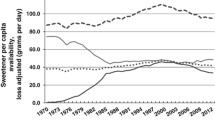Abstract
Dietary sugar has, for a long time, been pointed to as a cause of ill health, but not without controversy. Attention on sugar has heightened recently, partly in response to revisions of dietary guidelines on added sugar intake. There is now a substantial body of credible evidence that high added sugar intakes are detrimental for body weight and cardiometabolic health. Recommendations aiming to further reduce added sugar intakes are justified, however a range of public health action is needed to enable consumers to achieve this.
Similar content being viewed by others
References
Popkin BM, Nielsen SJ. The sweetening of the world’s diet. Obes Res. 2003;11(11):1325–32.
World Health Organisation and the Food and Agriculture Organisation of the United Nations. Diet, nutrition and the prevention of chronic diseases. Report of a joint WHO/FAO Expert Consultation. Geneva: World Health Organisation; 2003.
Ervin RB, Ogden CL. Consumption of added sugars among U.S. adults, 2005–2010. NCHS data brief, no 122. Hyattsville, Maryland: National Center for Health Statistics; 2013. http://www.cdc.gov/nchs/data/databriefs/db122.htm Accessed 31 August 2014.
Public Health England and Food Standards Agency. National Diet and Nutrition Survey. Results from Years 1–4 (combined) of the Rolling Programme (2008/2009 – 2011/12) 2014. https://www.gov.uk/government/publications/national-diet-and-nutrition-survey-results-from-years-1-to-4-combined-of-the-rolling-programme-for-2008-and-2009-to-2011-and-2012. Accessed 31 August 2014.
Ervin R, Kit B, Carroll M, Ogden C. Consumption of added sugar among U.S. children and adolescents, 2005–2008. NCHS data brief no 87. Hyattsville, Maryland: National Centre for Health Statistics; 2012. http://www.cdc.gov/nchs/data/databriefs/db87.htm Accessed 31 August 2014.
Te Morenga L, Mallard S, Mann J. Dietary sugars and body weight: systematic review and meta-analyses of randomised controlled trials and cohort studies. BMJ. 2013;346.
Hu FB. Resolved: there is sufficient scientific evidence that decreasing sugar-sweetened beverage consumption will reduce the prevalence of obesity and obesity-related diseases. Obes Rev. 2013;14(8):606–19.
Reedy J, Krebs-Smith SM. Dietary sources of energy, solid fats, and added sugars among children and adolescents in the United States. J Am Diet Assoc. 2010;110(10):1477–84.
Te Morenga LA, Howatson AJ, Jones RM, Mann J. Dietary sugars and cardiometabolic risk: systematic review and meta-analyses of randomized controlled trials of the effects on blood pressure and lipids. Am J Clin Nutr. 2014;100(1):65–79.
Malik VS, Popkin BM, Bray GA, Despres J-P, Willett WC, Hu FB. Sugar-sweetened beverages and risk of metabolic syndrome and type 2 diabetes: a meta-analysis. Diabetes Care. 2010;33(11):2477–83.
Sievenpiper JL, de Souza RJ, Cozma AI, Chiavaroli L, Ha V, Mirrahimi A. Fructose vs. glucose and metabolism: do the metabolic differences matter? Curr Opin Lipidol. 2014;25(1):8–19.
Darmon N, Drewnowski A. Does social class predict diet quality? Am J Clin Nutr. 2008;87(5):1107–17.
Compliance with Ethics Guidelines
ᅟ
Conflict of Interest
Gina L. Ambrosini declares that she has no conflict of interest.
Human and Animal Rights and Informed Consent
This article does not contain any studies with human or animal subjects performed by any of the authors.
Author information
Authors and Affiliations
Corresponding author
Rights and permissions
About this article
Cite this article
Ambrosini, G.L. Sugar: What Are the Current Facts and Where to Now?. Curr Nutr Rep 3, 299–301 (2014). https://doi.org/10.1007/s13668-014-0097-z
Published:
Issue Date:
DOI: https://doi.org/10.1007/s13668-014-0097-z




